Safe Passage: Friendly Skies for Migrating Birds
go.ncsu.edu/readext?960333
en Español / em Português
El inglés es el idioma de control de esta página. En la medida en que haya algún conflicto entre la traducción al inglés y la traducción, el inglés prevalece.
Al hacer clic en el enlace de traducción se activa un servicio de traducción gratuito para convertir la página al español. Al igual que con cualquier traducción por Internet, la conversión no es sensible al contexto y puede que no traduzca el texto en su significado original. NC State Extension no garantiza la exactitud del texto traducido. Por favor, tenga en cuenta que algunas aplicaciones y/o servicios pueden no funcionar como se espera cuando se traducen.
Português
Inglês é o idioma de controle desta página. Na medida que haja algum conflito entre o texto original em Inglês e a tradução, o Inglês prevalece.
Ao clicar no link de tradução, um serviço gratuito de tradução será ativado para converter a página para o Português. Como em qualquer tradução pela internet, a conversão não é sensivel ao contexto e pode não ocorrer a tradução para o significado orginal. O serviço de Extensão da Carolina do Norte (NC State Extension) não garante a exatidão do texto traduzido. Por favor, observe que algumas funções ou serviços podem não funcionar como esperado após a tradução.
English
English is the controlling language of this page. To the extent there is any conflict between the English text and the translation, English controls.
Clicking on the translation link activates a free translation service to convert the page to Spanish. As with any Internet translation, the conversion is not context-sensitive and may not translate the text to its original meaning. NC State Extension does not guarantee the accuracy of the translated text. Please note that some applications and/or services may not function as expected when translated.
Collapse ▲A journey of a thousand miles begins with a single flap.
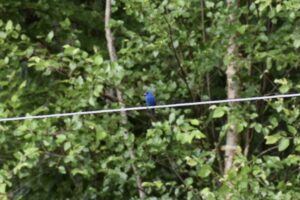
An Indigo Bunting (Passerina cyanea) perches on a power line just off the Yadkin River Nature Trail in Tanglewood Park. Indigo Buntings are nocturnal migrators that fly as far as 1200 miles in the fall to overwinter from South Florida into South America. Photo by: Rebecca Craps.
Every autumn, billions of birds undertake a treacherous journey south during fall migration. The skies over Forsyth County are part of an area known by scientists as the Atlantic Flyway. According to the Audubon Society, as many as 500 different species of birds will use this “avian superhighway” from late July through early December to travel from as far north as Greenland to the Caribbean, Central and South America to overwinter.
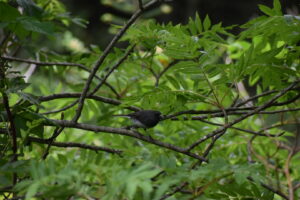
A Dark-eyed Junco (Junco hyemali) perches in a tree at Craggy Gardens just outside of Asheville, NC. Dark-eyed Juncos are especially susceptible to building collisions during fall migration. Photo by: Rebecca Craps
An article published in the winter 2018 issue of “Audubon” describes a study that was conducted to estimate the number of birds that do not safely make it through fall migration. The results estimated a staggering decrease of nearly 2.6 billion birds between fall and spring migrations (Saha 2018). For some of these birds, natural causes like weather and predation are to blame.
However, for many more, the challenges that come with higher population density and urbanization are the root cause. These challenges include glass collisions, feral cats, habitat loss, artificial light, and climate change. The good news is that there are many actions citizens can take to be good neighbors to migratory birds passing through.
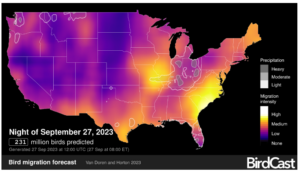
The BirdCast bird migration forecast tool shows 231 million birds predicted to migrate overnight on September 27, 2023. Areas in white, orange, and yellow should expect the largest numbers of migratory birds.
First, know when the highest numbers of birds are migrating. In the Piedmont Region of North Carolina, fall migration is most active during the months of September and October. A great tool for monitoring migratory bird activity is BirdCast. This tool allows you to view real-time migration data, as well as set migration alerts for any location you choose.
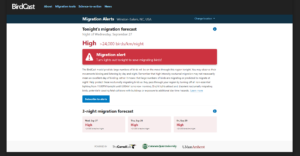
A screenshot from a BirdCast Migration Alert for Winston-Salem, NC, USA shows a High level of migration with a recommendation for turning lights out to help birds travel safely through the area
In addition to being aware of the rate of migration, there are many actions citizens can take at home to help make the skies over Forsyth County friendly for migrating birds.
- Turn off all non-essential lighting between the hours of 11 p.m. and 6 a.m. Most birds migrate at night and bright lights can attract and disorient them increasing building collisions and other hazards on the ground.
- Place anti-collision window decals on the outside of large windows.
- Make your backyard a Stopover Site. Stopover Sites provide food, water, and shelter for migrating birds.
- Food: replace non-native plants with native seed- and fruit-producing plants; put out feeders with seed blends (especially sunflower seeds), suet, bark butter, fruit, and nectar; clean feeders often to minimize spread of avian illnesses.
- Water: put out birdbaths; provide natural sources of water like streams, ponds, and creeks; clean birdbaths often to minimize spread of avian illnesses.
- Shelter: replace non-native plants with native plants; when possible, provide wooded areas, grasses, brush piles, leaf litter, fallen trees and branches; plant native evergreen trees.
- Provide indoor living space for free-roaming pets, especially cats. If outdoors, provide supervision to minimize predation.
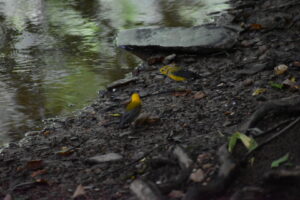
Prothonotary warblers (Protonotaria citrea) enjoying a stream in Uwharrie National Forest. Prothonotary Warblers migrate distances as far as 5,000 miles in the fall. Photo by: Rebecca Craps
Birds are a vital part of an ecosystem providing control of pests, pollinating plants, dispersing seeds, and acting as an indicator of the general health of the environment. Birds also provide a gateway for curiosity, wonder, and exploration in nature. There are many threats facing bird populations today, but the good news is that there is something everyone can do to help make their journey a bit lighter. And, if we all work together, we’ll get to experience the joy that comes with spotting a new species for the first time for years to come.




